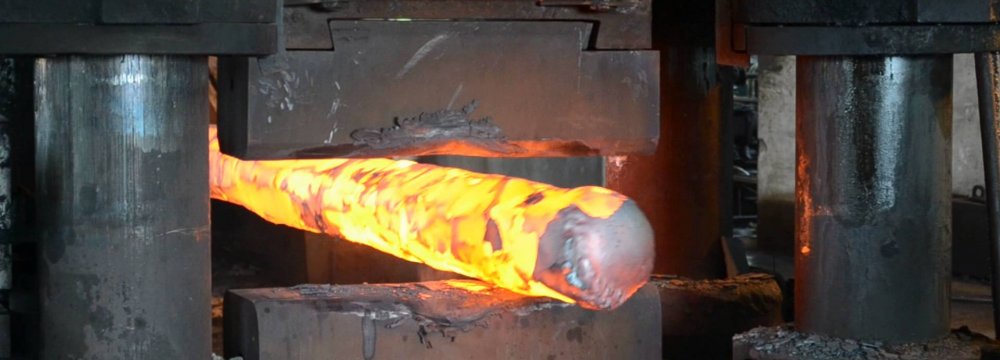The current situation in the domestic steel market has compelled most Iranian producers to shift their attention to exports. However, they need to tackle an array of problems including lack of funding, high transportation costs, strong international competition and unstable market environment.
During the 3rd Iran Steel Perspectives Conference held in Dubai, Metal Expert met Hussein Ahmadi, managing director of Khorasan Steel Complex. He elaborated on the company’s plans and perspectives, as well as challenges on the way to become one of the most important market players in Iran and the region. Excerpts of the interview:
Metal Expert: Khorasan Steel Complex is a major long steel producer in Iran. Could you tell us more about the company and its strategy?
Hussein Ahmadi: Khorasan Steel is the fourth largest steelmaking company in Iran which is transforming iron ore into rebar within a full production cycle. Our strategic advantage is integrated production chain, as we are the only company in the [Khorasan Razavi] province which has its own facilities and utilities from mine to rolling mills. Currently, we have two DRI units capable of producing 1.6 million tons per year and steelmaking facility with annual production capacity of 630,000 tons. Our rolling mills are able to produce 600,000 tons of rebar and 550,000 tons of light sections annually. All raw material requirements are being covered by Golgohar and Chadormalu mines, which supply pellets. However, when we complete the Sangan project, we will source iron ore from this mine and deliver by railway.
Our second steelmaking unit with a capacity of 720,000 tons per year and an iron ore processing plant capable of producing 2.5 million tons per year located close to Sangan mine near Khaf are under construction. In addition, to achieve corporate goals and consolidate production chain, the company is working on installation of one more continuous casting machine.
According to a ten-year development plan (ends in March 2026), we will balance our steel production chain from iron ore concentrate to finished steel and become an enormous production unit in the country and the Middle East. Production capacity of iron ore concentrate is going to reach 5 million tons, pellets – 5 million tons, DRI – 3.5 million tons, billet – 3.5 million tons, and finished steel – 1.3 million tons.
Business activity in northeast Iran, where the steel plant is located, is much slower than in southern or central parts of the country. How does this impact you? Who are your main customers?
Despite the easing of sanctions and slightly better economic environment, the domestic market in Iran is still weak regardless of the region. So, we have been trying to increase our exports since 2015. We export around one third of our rebar and billet output. If you cannot export, you are forced to sell domestically at a lower price to spur buyers’ interest. It is a vicious cycle and as a result we lose money and come to point zero. Thus, we should expand our export share.
Currently, our rebar export is estimated at around 100,000 tons per year. The volume, however, may depend on the situation, for example war or political issues in Afghanistan and Iraq. The company’s priority is to increase presence in the neighboring countries and secondly we will try to expand sales to other destinations as it is more difficult due to higher transportation costs. Our main customers are in Afghanistan, Pakistan, Turkmenistan, Kuwait, Tajikistan, Kyrgyzstan, Georgia, Azerbaijan, Iraq, the UAE, Oman, and the CIS countries. As high transportation costs are one of the main challenges for our company, we are trying to get some funding from the government to solve the problem.
The market environment is not stable due to oil prices fluctuations. As Iran is highly dependent on oil export revenues, low prices for hydrocarbons in the global market hurt the government budget and create deficits.
There are some expansion projects in your investment portfolio. Why did you decide to focus on upstream business development?
We plan to launch billet CCM to double our capacity from the current level of 630,000 tons. However, we face some challenges with billet manufacturing. If we are not active in exports, we have to produce larger volumes of end-products.
According to our target, we have to increase crude steel production to 2 million tons in the next five years. To reach this figure we have to supply all the utilities like water, oxygen, gas, and railway infrastructure. We do not have any problems with this issue, so the results will depend mostly on the market. We are negotiating with global equipment suppliers in order to acquire the state-of-the-art technology in the steel segment.
In particular, we have a contract with Italy’s Danieli. We have a plan to modernize our steelmaking plant, and now we are finalizing financing issues as per the contract. It will take one year to complete this project. Also, Japan’s Kobe will revamp our DRI plants in order to increase capacity to 2 million tons.






Add new comment
Read our comment policy before posting your viewpoints